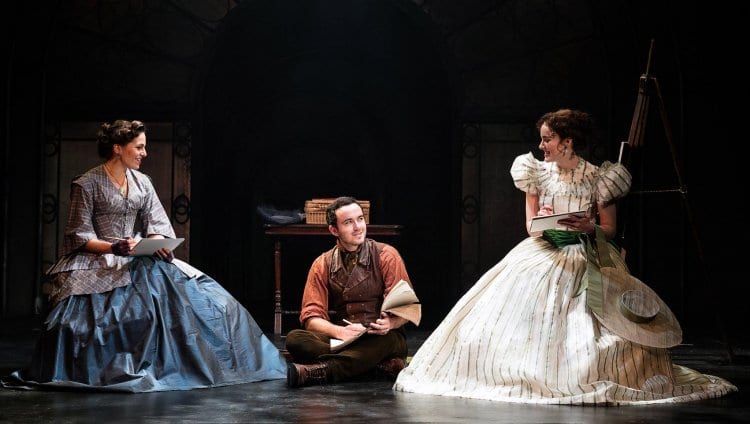It’s not often that a revival manages so completely to expunge the memory of the original production. However, Thom Southerland’s new staging of The Woman in White which has just opened at The Charing Cross Theatre is, I would argue, better designed, better dressed, better sung, better acted, and better directed than the original which left such a nasty taste in the mouth back in 2004.
The retained pieces of the plot of Wilkie Collins’ sprawling gothic novel are just about followable but more importantly without the added weight of the massive battling ego’s which blighted the first outing at The Palace Theatre more than a decade ago, the characters can at last start to shine through in their own right.
All that being said, and in spite of it feeling as if there might have been a little tinkering here and there, the problem still remains that Charlote Jones’ book just doesn’t have the superstructure to support the narrative.
The plot’s rather convoluted, but involves a pair of half-sisters, one of whom has inherited a fortune which an impecunious – indeed debt-ridden – baronet means to relieve her of by means of marriage. She also has a half sister who…well, I’m sure tickets are available, go and see it…
The problem is, that’s not what the book of the musical’s about. The book of the musical’s about a drawing master, Walter Hartwright (finely sung by Ashley Stillburn) who is sent off to a country house in the middle of Yorkshire and falls in love with one of the young women he’s tutoring, Laura Fairlie (Anna O’Byrne, in fine voice but with not much of a part to work with).
They are separated by the aforementioned evil baronet, Sir Percival Glyde (Chris Peluso) the brooding and violent villain of the piece. Then Hartwright just sort of disappears for half an act as the story moves back to the sisters and all sorts of peripheral stuff which has little to do with the original love plot. The other sister, Marian Halcombe, (nicely realised by Carolyn Maitland) at least has a bit of get up and go, and does, to London where after various adventures she meets back up with the drawing master who by now we’ve nearly forgotten about. Like I said, a bit of a dogs breakfast.
Where the songs don’t work they feel like music by the yard and David Zippel’s uncharacteristically clumsy lyrics don’t help, especially early on, when you get the real sense of the English language being pulled and twisted to fit the rhyme scheme. The fact that moments of Love Never Dies and Whistle Down the Wind, amongst others, keep popping up in the score doesn’t help.
Things aren’t all bad though. The most fully rounded character in the show is certainly Count Fosco (wonderfully sung and acted by Greg Castiglioni) and indeed if the writing of the other two and a quarter hours had been up to the standard of the scene’s he’s in, this might just have been a hit first time round.
The set in the original production was famously projected. It was awful. Morgan Large’s set here is simple, but effective, clever, and exceptionally well lit by Rick Fisher, giving the show a real sense of the gothic, and allowing for more than one ‘surprise reveal’.
All in all this isn’t a bad show per se. I’ve certainly seen far worse – and in this same theatre… but it’s a real shame that the material isn’t up to the craft which has been so generously lavished upon it.

